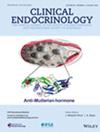Differences in Clinical Presentation Between Pheochromocytomas and Paragangliomas
Abstract
Objectives
Pheochromocytomas and sympathetic paragangliomas (PPGLs) are similar in most aspects. However, they differ in genetic etiology, hormonal secretion, and associated neoplasms. This study aimed to investigate differences in clinical presentation between PPGLs.
Design
This study employs a retrospective cohort design.
Patients
The cohort consists of 201 patients with PPGLs, including 196 with data on symptoms, treated at a major tertiary centre between 2005 and 2024.
Measurements
Data on age at diagnosis, sex, tumour size, metastases, genetic profiles, mode of discovery, pathology, biochemistry, symptoms, co-morbidities and blood pressure were collected from patients' medical records and compared between patients with pheochromocytomas and paragangliomas.
Results
Women were less prevalent in the pheochromocytoma group compared to the paraganglioma group (51.5% vs. 71.1%, p = 0.03). Pheochromocytomas produced more epinephrine (p < 0.001), though 25.0% of paragangliomas were also producing increased epinephrine concentrations. Most symptoms were similar between groups, but pheochromocytomas were associated with higher prevalence of palpitations (48% vs. 29%, p = 0.04) and anxiety (37% vs. 17%, p = 0.03) than paragangliomas. The pheochromocytoma group reported more symptoms (3 vs. 2, p = 0.01). Pre-diabetes/diabetes was more prevalent in patients with pheochromocytoma (45% vs. 24%, p = 0.02). The classic triad (palpitations, sweating, headaches) occurred in 12% of all patients, and hypertension in 82% of all patients, both being similar in prevalence between the PCC and PGL groups.
Conclusions
Pheochromocytomas and paragangliomas exhibit some notable differences in symptoms and hormone profiles but generally share many features. These distinctions are, however, insufficient for clinicians to differentiate the two tumours based solely on clinical presentation or biochemical data.


 求助内容:
求助内容: 应助结果提醒方式:
应助结果提醒方式:


